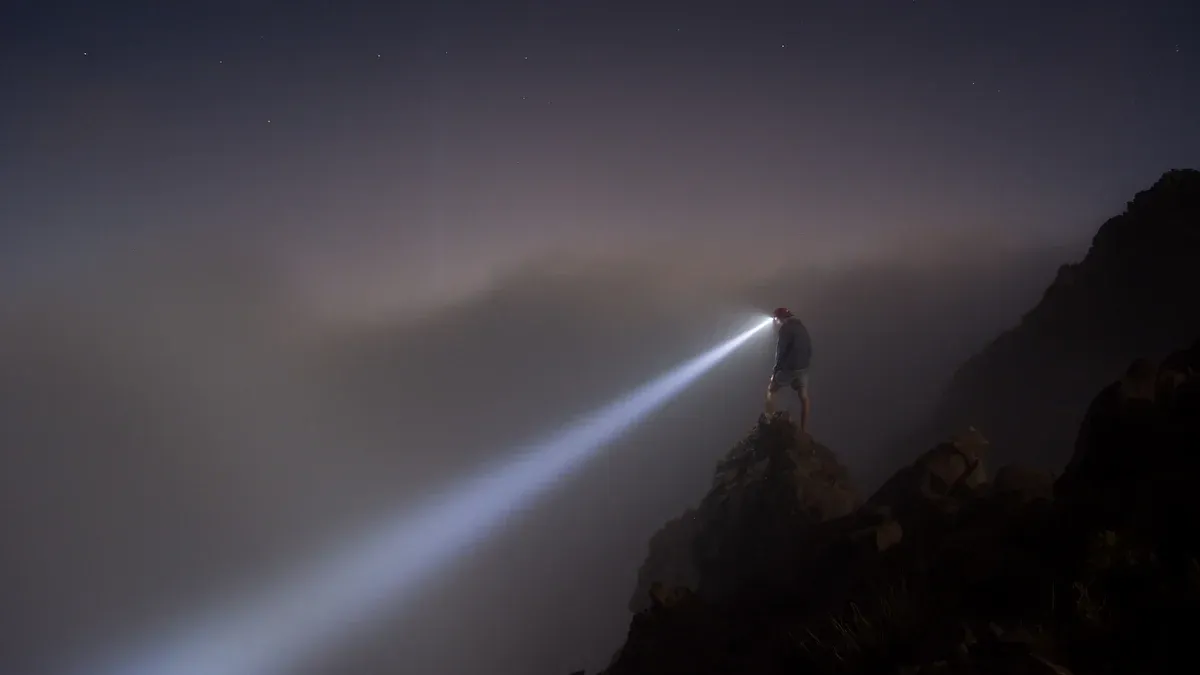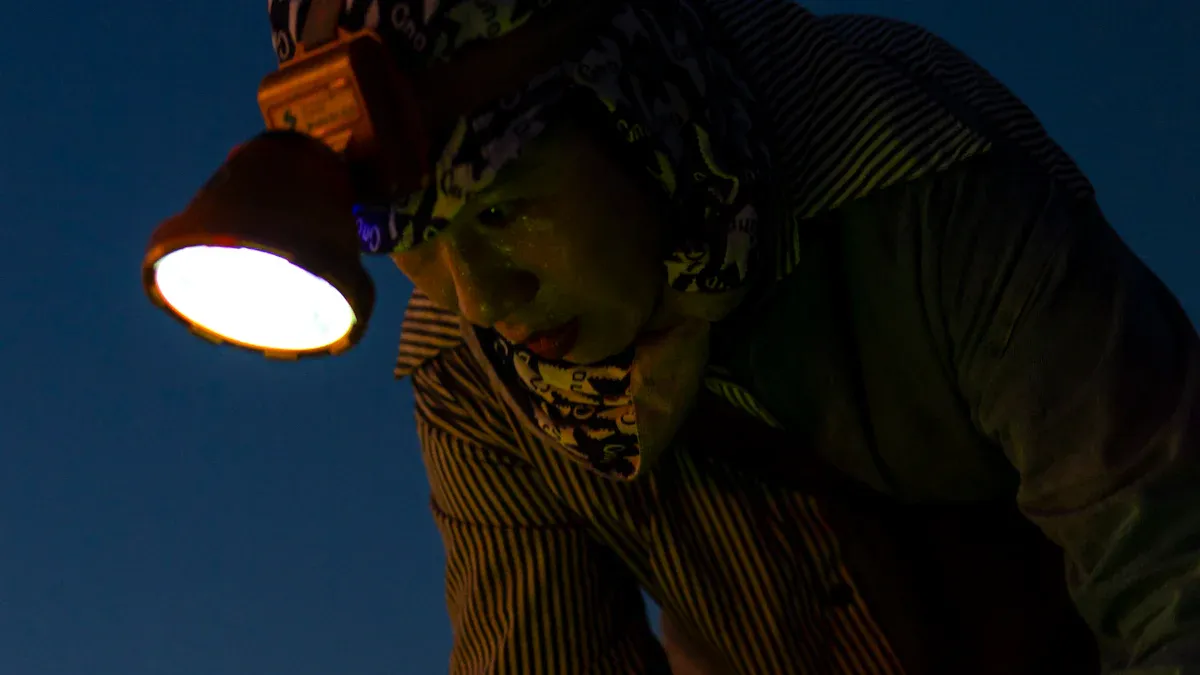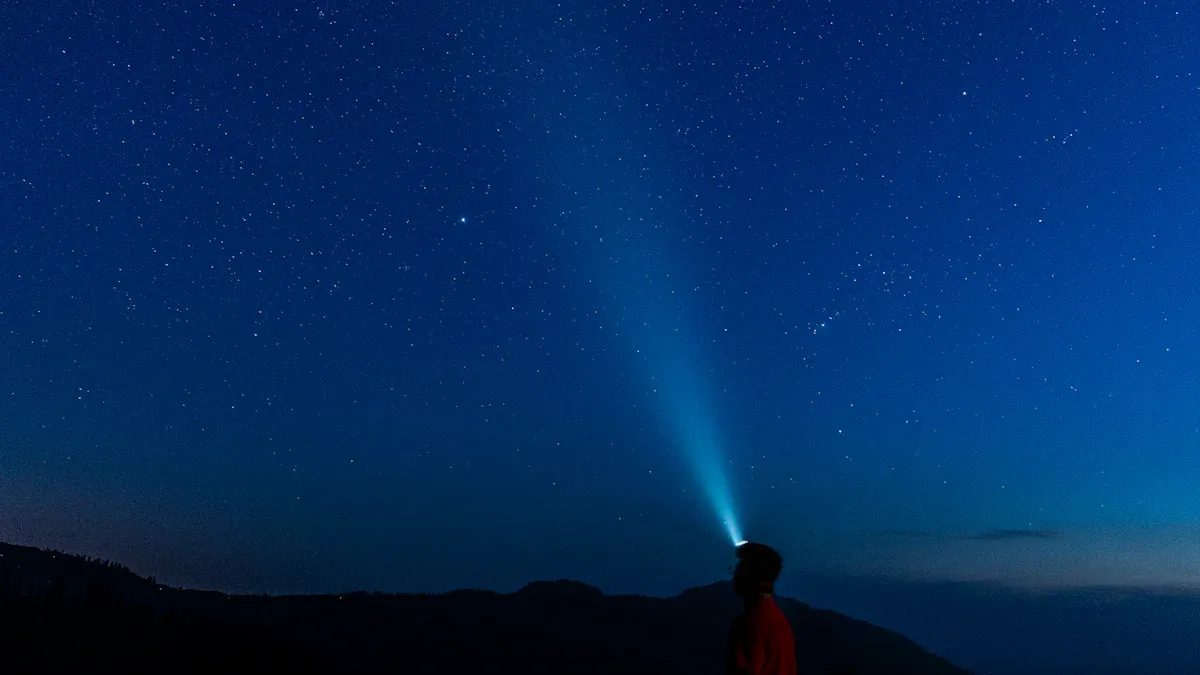Headlamp or Flashlight Which Fits Your Lifestyle Best

Choosing between a headlamp and a flashlight depends on how you plan to use it. Headlamps are perfect for hands-free tasks like setting up a tent or hiking after sunset. Flashlights, like the helius flashlight, offer better beam control and versatility. Your lifestyle and activities will guide your decision.
Key Takeaways
Headlamps keep your hands free, great for camping or hiking. They let you focus on tasks without holding a flashlight.
Flashlights give better beam control and are very flexible. They work well for emergencies and seeing far distances.
Think about how you will use it before choosing. Pick a headlamp for hands-free use or a flashlight for better control.
Benefits of Headlamps

Hands-Free Lighting
Headlamps are all about convenience. Imagine trying to set up a tent in the dark or carrying gear while holding a flashlight. With a headlamp, you don’t have to worry about juggling tasks. It keeps your hands free, making everything easier and safer.
A hands-free light means you can focus on what you’re doing without distractions. Whether you're climbing, hiking, or working in tight spaces, it’s a game-changer.
Modern headlamps also come with programmable features. You can adjust the brightness or set how long the light stays on. Plus, they’re built to handle tough conditions like rain, snow, or extreme heat. This durability ensures they’ll work when you need them most.
Ideal for Outdoor Activities
If you love outdoor adventures, a headlamp is your best friend. It’s perfect for activities where you need both hands.
Caving: Navigate dark caves while climbing or swimming.
Hiking: Read maps and find trails after sunset.
Camping: Light your way to the restroom or read in your tent.
Running: Stay visible and safe during night runs.
Biking: Illuminate roads or trails for better visibility.
Fishing: Bait hooks in the early morning darkness.
No matter the activity, a headlamp ensures you’re prepared for low-light situations.
Lightweight and Comfortable
You’ll barely notice you’re wearing a headlamp. Most designs are lightweight and sit snugly on your head. Adjustable straps make them comfortable for long periods. Unlike bulky flashlights, headlamps won’t weigh you down. This makes them ideal for extended use, whether you’re hiking for hours or working on a project.
With a headlamp, you get reliable lighting without sacrificing comfort. It’s a small tool that makes a big difference in your adventures and tasks.
Drawbacks of Headlamps
Limited Beam Control
Headlamps often lack the precision you get with a flashlight. The beam usually spreads out to light up a wide area, which can be great for general visibility but not ideal for focusing on specific objects. If you’re trying to spot something in the distance or need a concentrated beam, a headlamp might leave you frustrated.
Think about it: when you’re hiking at night and hear a rustle in the bushes, wouldn’t you want to point a sharp beam in that direction? With a headlamp, you’re stuck with wherever your head is facing. This can feel limiting, especially in situations where precision matters.
Potential Discomfort Over Time
Wearing a headlamp for long periods can get uncomfortable. Even though most designs are lightweight, the strap can start to feel tight or irritating after hours of use. If you’re sweating or wearing it over a hat, the discomfort might increase.
Pressure Points: The strap can press against your forehead, causing mild pain.
Adjustments: You might find yourself constantly readjusting it to stay comfortable.
If you’re planning to use a headlamp for extended activities, this is something to keep in mind.
Battery Life Challenges
Headlamps rely on batteries, and their lifespan can vary depending on the brightness settings. High-intensity modes drain power quickly, leaving you in the dark if you’re not prepared.
Pro tip: Always carry spare batteries or a portable charger. Running out of power in the middle of a hike or project can be a real headache.
Rechargeable headlamps are an option, but they still require regular charging. If you forget, you might find yourself without light when you need it most.
Benefits of Flashlights

Versatile and Ergonomic
Flashlights are incredibly versatile tools that fit seamlessly into your daily life and emergencies. Whether you're navigating a dark trail, signaling for help, or inspecting your car at night, a flashlight is your go-to companion.
They enhance safety by improving visibility in low-light conditions.
Tactical models with strobe lights or SOS signals can deter threats and assist in self-defense.
In emergencies, they illuminate escape routes and help you signal for rescue.
For example, hikers have used flashlights to find their way back in the Appalachian Mountains. Homeowners have even used them to blind intruders and call for help. A flashlight like the helius flashlight can be a lifesaver in these situations, offering reliability and ease of use.
Superior Beam Control
Flashlights excel in beam control, giving you the precision you need in various scenarios. Features like advanced optical systems and adjustable light intensity make them perfect for long-range observation or close-up tasks.
Feature | Description |
|---|---|
Advanced Optical Systems | Enhances beam focus and precision for better visibility. |
Adjustable Light Intensity | Lets you customize brightness for different environments. |
Customizable Beam Distances | Adapts to your surroundings, ensuring optimal lighting. |
User-Centric Designs | Ergonomic and intuitive, making them easy and comfortable to use. |
This level of control ensures you can adapt your flashlight to any situation, whether you're exploring a cave or searching for something in your backyard.
Durable and Reliable Options
Flashlights are built to last, even in the toughest conditions. Materials like stainless steel, titanium, and aluminum alloys ensure durability and reliability.
Material | Benefits |
|---|---|
Stainless Steel | Resists impact and maintains structural integrity. |
Titanium | Combines strength with corrosion resistance. |
Aluminum 6061 | Lightweight and durable, with excellent thermal properties. |
Aluminum 7075 | Tough and ideal for rugged environments. |
For added durability, many flashlights use hardened materials for the bezel and tail cap. This design ensures they can withstand drops and rough handling. Whether you're camping, working, or dealing with an emergency, a well-made flashlight won't let you down.
Drawbacks of Flashlights
Requires One-Hand Use
One of the biggest downsides of flashlights is that they tie up one of your hands. Imagine trying to fix a flat tire at night or carry groceries while holding a flashlight. It’s not impossible, but it’s definitely inconvenient.
You might find yourself wishing for an extra hand when you’re juggling tasks in the dark.
This limitation can slow you down, especially during activities that require both hands, like climbing or assembling gear. While some flashlights come with clips or mounts, they don’t always provide the same flexibility as a headlamp.
Bulkier to Carry
Flashlights, especially high-powered ones, can feel bulky. They often take up more space in your bag or pocket compared to a compact headlamp. If you’re packing light for a hike or trip, this extra weight can become a hassle.
Pocket-Sized Models: Convenient but may lack brightness.
Heavy-Duty Flashlights: Bright and durable but harder to carry.
You’ll need to decide if the added weight and size are worth the trade-off for better beam control and durability.
Less Practical for Hands-Free Tasks
Flashlights aren’t the best choice when you need hands-free lighting. Sure, you can prop one up or use a clip, but it’s not the same as having light that moves with you.
Picture this: You’re working under the sink, and your flashlight keeps rolling away. Frustrating, right?
For tasks like repairing, climbing, or running, a flashlight can feel like more of a hindrance than a help. If hands-free convenience is a priority, you might want to consider a headlamp instead.
Key Factors to Consider When Choosing
Intended Use and Activities
Your choice between a headlamp and flashlight starts with how you plan to use it. Different activities call for different features.
Purpose: Are you hiking, camping, or working on a project? A headlamp is great for hands-free tasks like setting up a tent, while a flashlight offers better beam control for exploring unknown terrain.
Comfort and Fit: If you’ll wear it for hours, look for a headlamp with adjustable straps and a lightweight design.
Durability: Outdoor adventures can be unpredictable. Waterproof and impact-resistant gear ensures your light source survives rain or accidental drops.
Tip: For long hikes, a flashlight might be better since you can easily replace its batteries. But for hands-free convenience, a headlamp is unbeatable.
Portability and Comfort
Portability matters when you’re on the move. Headlamps win here because they’re compact and multifunctional. You can wear them without adding bulk to your gear. Flashlights, on the other hand, tend to be bulkier due to their powerful batteries and LED bulbs. While they’re durable, carrying one in your pocket or bag can feel inconvenient during long trips.
If you value comfort and ease of use, a headlamp is the way to go. But if you need a powerful light source, a flashlight like the helius flashlight might be worth the extra weight.
Battery Life and Power Source
Battery life can make or break your experience. Headlamps often drain faster, especially on high-intensity settings. Always carry spare batteries or a portable charger to avoid being left in the dark. Flashlights generally offer longer battery life and easier replacements, making them ideal for extended use.
Rechargeable options are available for both, but remember to charge them before heading out. If you’re forgetful, a flashlight with replaceable batteries might be more reliable.
Budget and Durability
Your budget plays a big role in your decision. Headlamps are usually more affordable, but flashlights often provide better durability. Materials like aluminum or titanium make flashlights tough enough for rugged conditions. If you’re looking for a long-term investment, spending a bit more on a durable flashlight could save you money in the long run.
Specific Features (e.g., "helius flashlight")
Some flashlights stand out because of their advanced features. For example, the helius flashlight offers a high lumen output of 20,000 lumens, ensuring exceptional brightness. It also includes USB charging capabilities, making it easy to recharge from various sources. Plus, its waterproof design with an IPX5 rating ensures reliability in tough conditions.
When choosing, think about what features matter most to you. Do you need extreme brightness, or is portability more important? Matching the features to your needs will help you make the best choice.
Both headlamps and flashlights shine in their own ways. Headlamps are perfect for hands-free tasks like climbing or biking, while flashlights, such as the helius flashlight, offer unmatched beam control and durability. Think about your activities and preferences. Whether you’re an adventurer or need a reliable tool, there’s a perfect fit for you.
FAQ
How do I decide between a headlamp and a flashlight?
Think about your activities. If you need hands-free lighting, go for a headlamp. For precision and versatility, a flashlight works better.
Are rechargeable options better than battery-powered ones?
Rechargeable lights are eco-friendly and convenient. However, battery-powered options are more reliable for long trips where charging isn’t possible. Choose based on your needs.
Can I use a flashlight for hands-free tasks?
Yes, but it’s tricky. You’ll need a clip or stand to prop it up. A headlamp is much easier for hands-free lighting.
See Also
Selecting The Ideal Headlamp Flashlight For Your Needs
Discover The Best Flashlight For Daily Use
Light Up Your Camping Trips: Lanterns Or Flashlights?
Essential Tips For Buying The Right Headlamp Flashlight
Comparing Zoomable Flashlights And Reflector Caps: Your Choice
